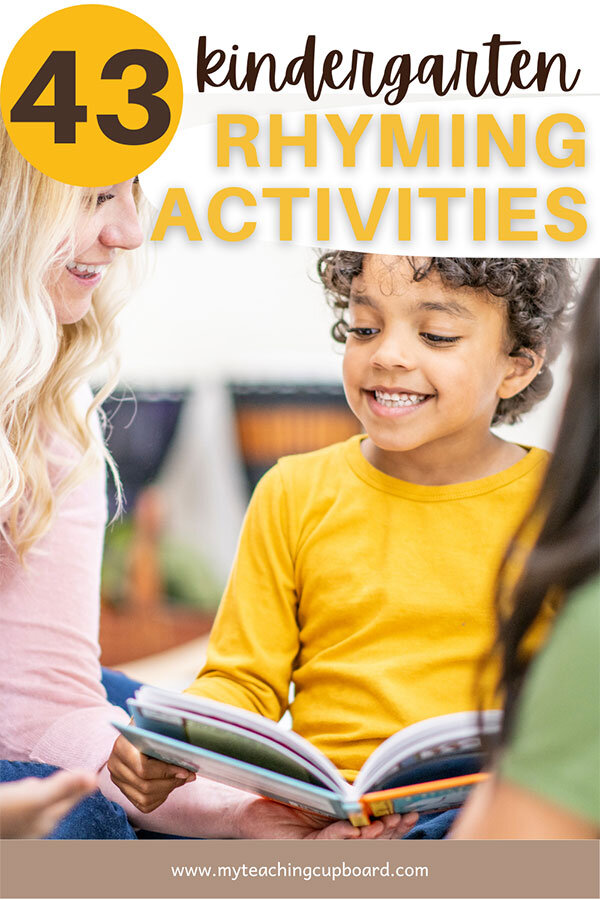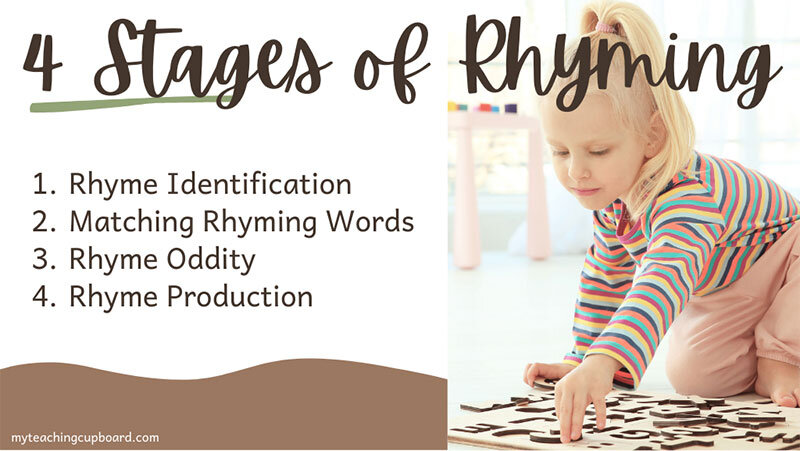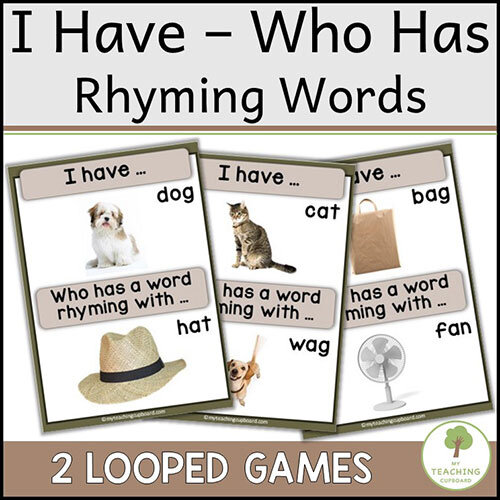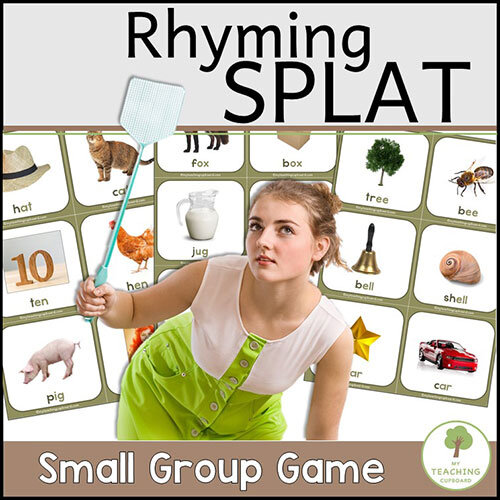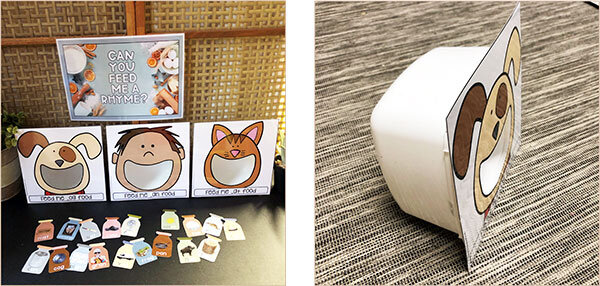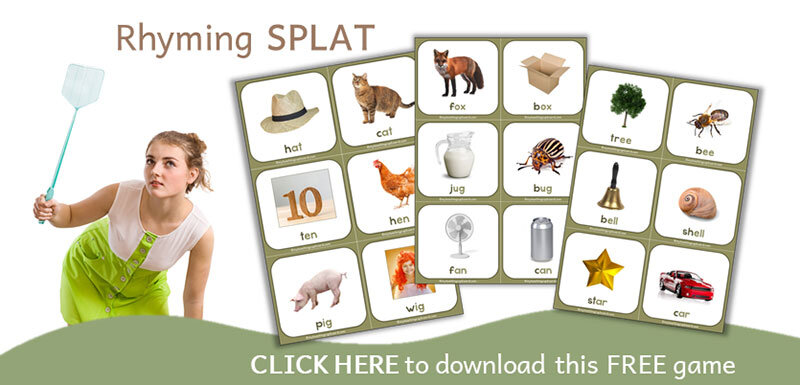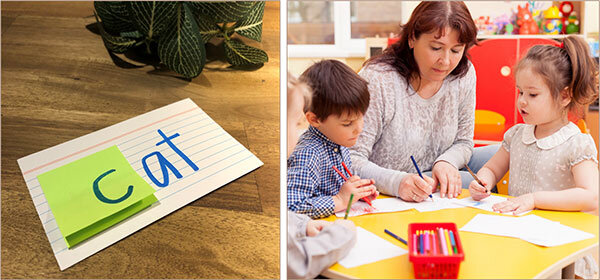43 Rhyming Activities for Kindergarten
Games and hands-on activities are a fun and effective way to teach rhyming. Kindergarten children love playing games so incorporating them into your literacy lessons is the perfect strategy for optimal engagement.
As you know, nothing beats hands-on learning to ensure the content and skills are mastered. You will find 43 hands-on learning ideas to implement in your classroom here in this blog post.
Before we dive into the rhyming activities, it is important to understand what rhyming is.
Is rhyming phonological or phonemic awareness?
Phonological awareness is an awareness of what sounds are and how they work together to make words. The smallest sound unit in speech is called a phoneme. There are 44 phonemes in the English language. Because phonological awareness is all about the ability to recognise, combine and manipulate phonemes, the terms phonemic awareness and phonological awareness are often confused.
Phonological awareness is the larger umbrella term covering ALL units of sound (not just phonemes). There are three strands of phonological awareness: syllable awareness, intra-syllable awareness, and phonemic awareness. Phonemic awareness is a sub-strand of phonological awareness.
Rhyming is part of intra-syllable awareness. Intra-syllable awareness includes the ability to both segment and blend the syllables in words. Intra-syllables are the sound units we often refer to as onset and rime.
The stages of phonological awareness
Phonological awareness does not seem to develop in a particular developmental sequence, but some elements do appear to be more difficult than others to master. Kindergarten students seem to be able to split words into onsets and rimes much more easily than they can manipulate the individual phonemes (sounds) within words.
There are 4 levels of difficulty within the phonological skill of rhyming.
Identifying rhyme – Does hat rhyme with cat?
Matching rhyming words – Which one rhymes with hat? Pig or cat?
Oddity – Which one doesn’t rhyme? Hat, pig, cat.
Producing rhyme – Give me a word that rhymes with hat.
The rhyming activities in this blog post are organised into the 4 levels of rhyming difficulty. This will help you differentiate your teaching and choose an activity suited to the skill level of your particular students.
Activities for Identifying Rhyme
Rhyming Names Game. This is a fun movement rhyming activity. Movement always keeps children engaged but this one has the added bonus of using the children’s names – so there are two reasons your children will love this nonsense rhyming game. You will need to make up nonsense rhyming words for the names of the children in your class and say, “If your name rhymes with Rames, touch you head. If your name rhymes with Parah, jump 3 times.” This is a good circle time activity and also a quick and easy game to play when you are waiting for the school bell to ring.
Hands On Heads. When reading a rhyming story to your class, ask the children to listen for rhyming words. If they hear any, they put their hands on their heads. A simple and fun activity to get your students to start listening for and recognising rhyming words. If you are interested in rhyming books, there is a list of 79 Rhyming Books for Kindergarten and Preschool HERE on this blog post.
Silly Voices. To follow on from the above activity, when you are reading a rhyming story to your class and you have identified some rhyming words, it is so much fun to say the words using silly voices. Say the rhyming words and have the children repeat them using silly voices. Some of our favourite silly voices are: in a baby voice, in a dinosaur voice, in a dad voice, like a mum talks, say them in a principal’s voice (that one is always interesting!!) The children love a bit of nonsense and this activity is so easy to do.
Rhyming Hide and Seek. Hide pictures of objects around the classroom or out in the playground. Give each child a matching rhyming picture checklist to tick off the rhyming pictures they find. The children love to search for the hidden pictures.
Rhyming Basket. Make a rhyming basket by putting a collection of small rhyming objects into a basket for the children to investigate. A rhyming basket is a great addition to an investigation area. You can read more about our rhyming basket HERE. The Rhyming Basket blog post has a list of easy to find rhyming objects you can add to your class rhyming basket.
Feely Bag. When you have a collection of small rhyming objects as mentioned in the above rhyming basket activity, you can use these to make a feely bag. Put the rhyming objects into a pillowcase. The children then take turns to pull out two objects. If the two objects rhyme, they get another turn. If they don’t rhyme, the objects are placed back into the bag and the next person has a turn.
I Have Who Has. This activity is great one for whole class or small group literacy lessons. You will need a set of cards with 2 rhyming pictures on each card. One picture is a rhyming answer and the other, a rhyming question. The person with the starting card asks their “who has a picture rhyming with…” question. The student with the correct rhyming answer says “I have!” and then asks their “who has…” rhyming question that is on their card. The game continues in this question and answer pattern until the entire deck of cards has been played and every child has had a turn. There is a set of 24 looped CVC rhyming picture cards HERE if you would like to play this fun game with your class.
Rhyming Splat. For this super fun activity you will need some rhyming picture cards and 2 fly swats. The rhyming pictures are randomly placed on a table. The children sit around the table with the teacher. Two children take a fly swat each and listen for the teacher to say a word which rhymes with one of the pictures on the table. They race to SPLAT the matching rhyming picture with their fly swat. The child to splat the correct picture first keeps the fly swat for another turn. The other child passes their fly swat to the child next to them and the game continues. You can download the pictures for Rhyming Splat HERE in the FREE resource Library.
PowerPoint Activity. Teach rhyming with a fun PowerPoint presentation. Children can identify rhyming words and non-rhyming words. They will also learn rhyming words have the same ending sound if you make each pair of rhyming words presented in the PowerPoint from the same word family. Make a presentation, with each slide showing two pictures, if they rhyme, the children can put their thumbs up. If they don’t rhyme, they put their thumbs down. Make the second slide in the sequence self-correcting by telling the children: YES—they have the same ending sound or No— they do not have the same ending sound. Your class will love putting their thumbs up or down and checking if they are correct. If this sounds like an activity your class might enjoy, you can download an already prepared PowerPoint HERE.
Activities for Matching Rhyming Words
Picture Sorts. Rhyming picture sorts can be incorporated into many different hands-on learning activities. Use printed clip art pictures, magazine pictures, or children’s drawings for your rhyming pictures. Use picture sorts as literacy activities for investigation areas, literacy centres or in literacy group rotations.
Rhyming Match. This activity is easy to set up. Put real life rhyming items (or pictures) into a basket and add a few sorting bowls so the children can sort and match the word family groups. You can use small hoops or placemats in place of the sorting bowls. Rhyming Match would be an excellent hands-on addition to a rhyming investigation area or literacy center.
Stick a Rhyme. This is an easy activity for teaching children to match rhyming words. All you need is a whiteboard and sticky-notes. There’s something super engaging about sticky notes! Draw a few columns on the whiteboard and write a word at the top of each column. You might like to make five columns and choose a different vowel sound for each. Then, write word family words to match on the sticky notes. Give out the sticky notes to the children and have them come up and place their sticky note under the matching word family column.
Walk the Tightrope. Glue rhyming pictures to footprint cut-outs. Place the footprints in a walking line on the floor. Make sure to place rhyming pairs close to each other with one picture for the left foot and the matching picture for the right foot. Have children say the rhyming words as they step on the pictures. As an extension activity, the rhyming pairs could be mixed up so children have to hop from one rhyming word to another.
Rhyming Rocks. Make some rhyming story stones using small rhyming pictures or stickers. Check out this post over at Little Lifelong Learners if you would like to know how to make story stones. Add your rhyming rocks to a large sensory tray of gravel along with a few toy diggers and dump trucks. You can download rhyming story stone pictures, rhyming provocation prompts and detailed instructions as part of The Rhyming Investigations Pack HERE if you are interested in this rhyming activity.
Driving to Rhyme. Another way to learn about rhyming words in an engaging hands-on way is by using some of the children’s favourite toys. Tape rhyming pictures to trains, trucks, or cars and have the children drive the vehicles to a matching rhyming picture.
Bubble and Brew. Place a Bubble and Brew provocation poster next to a sensory tray filled with your choice of filling. Some of our class favourite fillings are coloured rice, sand, bird seed or dried corn kernels. Into the filling, add a couple of small saucepans to act as sorting bowls. Then add small items or pictures representing two or three rhyming word families. You might like to add some measuring spoons and cups to integrate early math measurement concepts too. You can download the Bubble and Brew learning provocation prompt and rhyming pictures HERE. This rhyming provocation is part of The Rhyming Investigations Pack.
Rhyming Bingo. Bingo is a staple activity in most classrooms and the perfect game to play during literacy groups or rotations. Children love this fun, educational game and you can get the rhyming version HERE - Rhyme Time Bingo
Feed the Animals. Use shoe boxes (or other small boxes) to create different animals. Cut a hole for the mouth of each box animal. Then make rhyming food for the animals to eat. For example, one box could be a dog and children can feed the dog by putting rhyming bones into its mouth. The bones would have rhyming pictures on them. There is a version of this activity in the Rhyming Investigations Pack. It includes instructions and printables to make a dog, a cat and a man along with their rhyming food.
Dinner Time. If you have children who enjoy imaginative play, they will love this rhyming activity. Tape a rhyming picture from a few word families to plastic plates in your dramatic play home corner or restaurant. The children can then use spatulas, tongs or chopsticks to put matching word family pictures onto the correct plates.
Rhyming Race. This is a great outdoor movement game. You will need a class set of rhyming picture pairs to play this game as a whole class. If you are playing as a small group, you will only need a few sets of rhyming pictures. You could use the rhyming pictures from the FREE Splat Game Here. Pin a picture to each child’s shirt. All of the children run around the playground until you yell “Rhyme Race!” Then the children race to find their matching partner. Whoever gets to their partner first, is the winner, winner, chicken dinner 🤩
Rhyming Hopscotch. Use tape to create a hopscotch game inside, or chalk for an outside game. Put rhyming pictures inside each hopscotch square. The teacher says a word rhyming with one of the pictures and the children take turns hopping to the matching rhyming picture and back.
Catch a Rhyme. For this word family game you will need to make a fishing rod out of a stick, a piece of string and a magnet (for the hook). Attach paper clips to pictures representing two or three word families face up on the floor. The children can catch the matching word family pictures by using the magnetic fishing rod. This would be another fun activity for investigations or literacy groups.
Rhyming Towers. Print and cut out word family words to stick onto building blocks. You could use duplo, jenga or mega blocks. The children can build rhyming towers by stacking all the blocks from the same word family. There is a provocation prompt poster and 39 word families all ready to download and print in the Rhyming Investigations Pack HERE.
Write the Room. In this rhyming activity, the teacher hides illustrated rhyming cards around the room for the children to find. The children need a pencil and a recording sheet each. They walk around the room searching for the hidden cards and when they find one, they write the word on their recording sheet next to a matching rhyming picture. You can download the pictures and a recording sheet for a Rhyming Write the Room HERE if you would like this activity already prepared for you.
Cross the River. For this whole class rhyming activity, the children make 2 equal lines on either side of your carpet space. The teacher gives each child a cvc picture card. You can download the picture cards I use for this rhyming game from my FREE Resource Library HERE. While you are giving out the pictures, encourage the children to look at their picture and to tell a friend any matching rhyming words they can think of. Once every child has a picture, the teacher walks up and down the riverbanks (lines of children) and randomly says a word to rhyme with one of the children’s pictures. The child with the matching rhyming picture jumps up and crosses the river by running across the river carpet space and finding an empty spot to sit on the opposite riverbank. The game continues with the teacher saying matching rhyming words until every child has had a turn of running across the river. My class just love playing Cross the River. Children are always up for a game that involves movement!!
Rhyming Stomp. To play Rhyming Stomp, all the children sit in a circle on the floor. Rhyming pictures are randomly placed on the floor inside the circle. The teacher sits in the circle between any 2 children. The 2 children either side of the teacher stand. The teacher says a rhyming word for one of the pictures within the circle. The first child to race and stomp on the correct matching rhyming picture is the winner. Both children return to their places on either side of the teacher. The winning child stays standing ready to compete against the next competitor. The next competitor is the child sitting right next to the losing child. This competitor stands and races against the current winner to find the next matching picture for the word said by the teacher. The game continues around the circle until everyone has had a turn and you have the grand champion.
Snowball Fight. You will need to print pictures of rhyming words onto paper. Each child is given a picture to crumple up into a snowball. They hold onto their rhyming snowball until the teacher says, “Snowball Fight!” The children start throwing their snowballs around the room. After about 30 seconds of snowball fighting, signal the children to stop and open the closest snowball to reveal their rhyming picture. Each child must then find their rhyming partner. These rhyming snowballs can be reused. You will definitely want to reuse them because the children will love playing this game. It is a regular favourite in our classroom.
Rhyming Clip cards. Clip cards have a large picture on the top of each card and three smaller pictures below. One of the smaller pictures rhymes with the larger picture and the other two don’t. The children peg a clothespin onto whichever bottom picture they think is a match and rhymes with the large top picture. To make the cards self-correcting, place a mark or small sticker on the back of each card to highlight the correct answer. When children peg on their clothespin, they can flip the card over to see if they are correct. This activity is ideal for independent work or explicit teaching in literacy groups and can also be added to busy bags, literacy centers or investigation areas. You can download this engaging hands-on activity HERE in my store.
This product includes 36 illustrated CVC rhyming playing cards and printable instructions explaining how to play 6 easy card games to teach your students all about word families and matching rhyming words. The word families in these card games include: _at _ et _en _og _an _ap _ip _un _ug.
Perfect for
literacy groups
literacy rotations
word work activities
explicit teaching lessons
literacy centers
play based investigation areas.
Activities to Teach Rhyming Oddities
One of These Things is Not Like the Other. This is a simple game children enjoy. You simply need a few sets of illustrated word family cards. Display 3 cards to the children. Two of the cards from the same word family (rhyming) and one from a different family (non-rhyming). The children say the one which is not rhyming and not like the others.
Rhyming Clip cards. These can be the same cards used in the matching rhyming words activity. Clip cards have a large picture on the top of each card and three smaller pictures below. One of the smaller pictures rhymes with the larger picture and two are rhyming oddities. The children peg a clothespin onto whichever bottom picture does not rhyme with the large top picture. To make the cards self-correcting, place marks or small stickers on the back of each card to highlight the correct answers. When children peg on their clothespin, they can flip the card over to see if they are correct. You can download a set of 32 rhyming clip cards HERE in my store.
Rhyming Splat. This fun game is one used to identify rhyme but can also be used to teach children to find the rhyming oddity. To play, you will need some rhyming picture cards and 2 fly swats. The rhyming pictures are randomly placed on a table. The children sit around the table with the teacher. Two children take a fly swat each and listen for the teacher to say a word. The players race to SPLAT any picture which does not rhyme. The child to splat a correct picture first keeps the fly swat for another turn. The other child passes their fly swat to the child next to them and the game continues. You can download a set of pictures for Rhyming Splat HERE in the FREE resource Library.
Rhyming Jump. Place pictures from the same word family in a line on the floor. Every now and then, in the line, add a few pictures which are not part of your chosen word family. The children jump on each picture in the line which is part of the rhyming word family but must jump over all those which do not belong. Incorporating movement into your literacy lessons is not only so much fun but it also helps young children activate their brain and strengthen neural pathways.
Activities to Teach Rhyme Production
Read-A-Louds. When it comes to teaching rhyme production, read-a-louds are my go-to resource. Choose a rhythmic rhyming book to read aloud to the children. If you are looking for inspiration, there is a list of 79 kindergarten and preschool rhyming books HERE. As you read the story, pause at the rhyming words to give the children the opportunity to predict and produce the rhyming word. You will be developing a love of reading, but also teaching rhyme production.
The Name Game. This is an easy to play game which children love. To play, you will need a set of magnetic letters. Write a child’s name onto a whiteboard and have the class read it. That child then comes to the front and chooses a magnetic letter. The magnetic letter is placed on top of the first letter of their name on the whiteboard. (Lauren, Bauren) If their name begins with a vowel, the magnetic letter needs to be placed in front of their name. (Elliot, Pelliot) Everyone now says the child’s name and the new rhyming word. So simple, but the children just love playing this one. An alternative game can be played where the teacher says only the rhyming word (Pelliot) and then the children say the name that rhymes (“Not Pelliot, it’s Elliot!”).
Rhyming Ladders. Rhyming ladders is a rhyme production activity suitable for whole class or small group lessons. Start by drawing a ladder on the whiteboard. Write a word at the bottom of the ladder. The children then suggest words which rhyme with the base word. The teacher or a child writes the word on the next rung of the ladder. You can teach your students to see the phoneme substitution of rhyming words with this activity. As they are thinking of suitable rhyming words, prompt them to change the beginning sound in the word to produce a new rhyming word. This will help them to see that even though the beginning sound changes, the ending stays the same.
Rhyming Word Trains. This activity is a good one for teaching children to produce rhyme. You will need the rhyming train worksheet which you can download for free HERE. Show the children a picture or tell them a word. They draw or write it on the train engine. Then, the children can draw or write words which rhyme on the train carriages.
Obstacle Course. Set up an obstacle course using climbing frames, balance beams, stepping buckets, jumping hoops etc. Stick a rhyming word or picture onto each piece of equipment. As the children make their way through the course, they must produce a word to rhyme with the picture on their piece of equipment.
Jumping Hoops. Place a few hoops in a line on the ground. Put a rhyming word or picture inside each hoop. The children produce a matching rhyming word as they jump into each hoop.
Stick a Rhyme. This easy activity can be used to teach rhyme production. It is similar to the one outlined above in the activities for matching rhyming words. You will need a whiteboard and sticky-notes. Draw a few columns on the whiteboard and write a word at the top of each column. As in the matching activity, you might like to make five columns and choose a different vowel sound for each. Then, give a blank sticky note to each child. They can write or draw a rhyming word to stick under their choice of one of the word family columns.
Rhyming I Spy. This game is a classic favourite. To play Rhyming I Spy, the first child gives a rhyming word as the clue instead of the traditional first letter. For example, if the child chooses a chair, they say, 'I spy with my little eye something rhyming with bear'. The other children then take turns to guess the rhyming answer. Allow the children to invent rhyming nonsense words to make the game easier to play.
Rhyming Circle. This is a fun no-prep circle time game. The children sit in a circle with the teacher. The teacher says a word out loud and the next child has to produce a word which rhymes with the teacher’s word. (Allow nonsense words) Continue around the circle until all the children have had a turn.
Rhyming Flip Books. Giving children the opportunity to make their own rhyming flip books is a great activity for small group rotations, literacy centers and investigation areas. Peel off a few sticky notes and stick them onto a strip of card. Write an ending word family rime onto the right hand side of the card and stick the pile of sticky notes on the left. The children can write onsets onto each sticky note. The onsets can be flipped to produce word family words. Your children will enjoy reading their rhyming flip books to their friends. For extra rhyming practice, place the rhyming flip books in a basket and add them to your class library area.
These 43 rhyming games and hands-on activities are well loved by the children in my class so I know your children will love them too!! If you like these fun rhyming activities, please consider sharing this blog post...
Just CLICK the sharing box below.👇

